Rail transport in Norway
| Norway | |
|---|---|
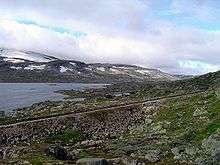 Bergensbanen at Finse, the highest point of the Norwegian railways. | |
| Operation | |
| National railway | Norges Statsbaner |
| Infrastructure company | Jernbaneverket |
| Statistics | |
| Ridership | 58.4 million (2010)[1] |
| Passenger km | 3,134 million (2010)[1] |
| Freight | 27.2 million tonnes (2010)[2] |
| System length | |
| Total | 4,087 kilometres (2,540 mi) |
| Double track | 242 kilometres (150 mi) |
| Electrified | 2,622 kilometres (1,629 mi) |
| High-speed | 64 kilometres (40 mi) |
| Track gauge | |
| Main | 1,435 mm (4 ft 8 1⁄2 in) |
| Electrification | |
| Main | 15 kV 16 2⁄3 Hz AC |
| Features | |
| No. tunnels | 696 |
| Longest tunnel | Romeriksporten |
| No. bridges | 2,760 |
| Longest bridge | Strømsløpet Bridge |
| Highest elevation | 1,237 metres (4,058 ft) |
| at | Finse |
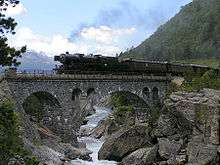
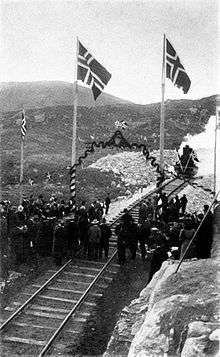
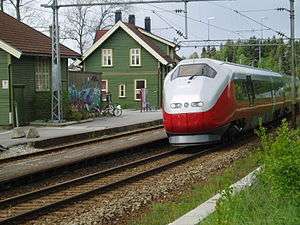
The Norwegian railway system comprises 4,087 km of 1,435 mm (4 ft 8 1⁄2 in) (standard gauge) track of which 2,622 km is electrified and 242 km double track. There are 696 tunnels and 2760 bridges.
Jernbaneverket is a state owned agency which builds and maintains all railway tracks, while other companies operate them. These companies include Norges Statsbaner, NSB Anbud, CargoNet, Flytoget, Hector Rail, Tågåkeriet and Ofotbanen.
Norway is a member of the International Union of Railways (UIC). The UIC Country Code for Norway is 76.
History
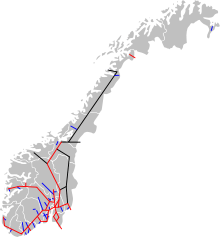
— electrified lines
— non-electrified lines
— disused or heritage lines
The first railway in Norway was Hovedbanen between Oslo and Eidsvoll and opened in 1854. The main purpose of the railway was to freight lumber from Mjøsa to the capital, but also passenger traffic was offered. In the period between the 1860s and the 1880s Norway saw a boom of smaller railways being built, including isolated railways in Central and Western Norway. The predominant gauge at the time was 1,067 mm (3 ft 6 in) (narrow gauge), but some lines were built in 1,435 mm (4 ft 8 1⁄2 in) (standard gauge). The height of the era came in 1877 when Rørosbanen connected Central Norway to the capital. In 1883 the entire main railway network was taken over by NSB, though a number of industrial railways and branch lines continued to be operated by private companies.
Three urban railways, in Oslo, Bergen and Trondheim, were started as in 1875 (Oslo), 1897 (Bergen) and Trondheim (1901. Oslo's system as the only one, started with horse cars, the two other as with electric cars. Electric cars were introduced in Oslo in 1894 and the last horse car operated in 1900.
Bergen closed down its 1. generation system between 1944 and 1965, but (re-)introduced LRT in 2006.
The second construction boom of the main railway arose in the 1910s and included the Bergensbane across Finse to Bergen, connecting Eastern and Western Norway. Also a number of other larger projects were built through the 1920s, including a second line, Dovrebanen, to Trondheim. This period also saw the first electrified railways and a steady conversion from narrow gauge to standard gauge. Norway chose to electrify their network at 15 kV 16 2⁄3 Hz AC.
During World War II there was a massive construction by the German Forces as part of creating Festung Norwegen, including large sections of Nordlandsbanen and the completion of Sørlandsbanen. After the war the main effort was to complete Nordlandsbanen (that reached Bodø in 1962) and completing the decision to electrify 50% of the network, a task not completed until 1970. This allowed the retirement of the steam locomotive, being replaced with electric engines like the El 11 and El 13 or the diesel powered Di 3. In 1966 Norway's only rapid transit, Oslo T-bane was opened, but in the same decade the Bergen tramway was closed. In the 1970s and 80s a lot of branch lines were also abandoned.
In 1980 the massive project of connecting the eastern and western railway networks around Oslo was completed with the opening of the Oslo Tunnel and Oslo Central Station. In 1996 NSB was split in the Norwegian Railway Inspectorate, Jernbaneverket and operating company NSB BA. Since the companies have been split into 10 separate companies and corporations. In 1998 the first new line in 36 years was opened when the high-speed railway Gardermobanen was opened to allow travel at 210 km/h between Oslo, Oslo Airport and Eidsvoll. The 1990s also saw the massive introduction of multiple units on passenger trains. In the 2000s the freight segment was deregulated and a number of freight companies have started competing with the NSB partial subsidiary CargoNet.
Network
Track
The main railway network consists of 4087 km of lines, of which 262 km is double track and 60 km high-speed rail (210 km/h). In addition there is 225 km of urban railways, of which 218 km is double track. In addition there are some industrial tracks and minor branch lines and some abandoned and heritage railways. The entire main network is 1,435 mm (4 ft 8 1⁄2 in) (standard gauge), as are the urban railways in Oslo and Bergen. Of the operational railways in Norway, only the Trondheim Tramway has a different gauge, the meter gauge, 1,000 mm (3 ft 3 3⁄8 in). Some heritage railways, though, operate with various kinds of narrow gauge.
Kirkenes-Bjørnevatnbanen used to be the northernmost railway in the world, but was in 2010 beaten by the Obskaya–Bovanenkovo Line in Russia. Still, Narvik is one of the northernmost towns in the world to have a railway connection, as the terminus for Ofotbanen. It connects to Kiruna, Sweden, but not to Bodø, the northern terminus of the Norwegian railway network. Kiruna is, however, connected to the Swedish railway network, which again is connected to the Norwegian network at the Swedish station of Charlottenberg, Storlien and Kornsjø.
Traction
2622 km (64%) of the railway network is electrified, all of it at 15 kV 16 2⁄3 Hz AC with overhead wires. The only sections that are not electrified are the lines north of Mjøsa, with the sole exception of Dovrebanen and the Ofotbanen. On non-electrified sections diesel locomotives are used. All of the urban railways use 750 V DC, via overhead wires on the tramways and via third-rail on the Oslo T-bane.
Future expansion plans
In its plans, Jernbaneverket will concentrate its expansions primarily on the cramped network around Oslo and the larger cities.
- Oslo-Ski: New doubletrack in new corridor for intercity trains finished in 2018. Existing doubletrack is used for local- and freight trains.
- Skøyen-Asker: New doubletrack in new corridor for intercity and freight trains. Existing doubletrack is used for local trains.
- Vestfoldbanen: Before 2019: 17 km doubletrack connected to existing doubletrack from Drammen, and 5,5 km doubletrack north of Tønsberg. Between Larvik and Porsgrunn ca 25 km of new doubletrack will cut 22 minutes of travel time. The plan is to make the whole line doubletrack after 2019.
- Sørlandsbanen: Plans may include a new line through Drangsdalen, and connect Sørlandsbanen to Vestfoldbanen between Porsgrunn and Skorstøl.
- Østfoldbanen: before 2019: Østfoldbanen is today double track both north and south of Moss, but in Moss 10 km remains as a single track bottleneck. Plans is to build a tunnel under Moss. There are also plans to build a new 22 km long fast railway from Oslo and south. After 2019 the plan is to build double track further south to Halden, along the present route. The plans of a direct high-speed railway seems to be abandoned for now and will be hard to motivate if there is 200 km/h double track in place.
- Ringeriksbanen is a planned railway between Sandvika and Hønefoss that will reduce travel time between Oslo and Hønefoss/Bergen by 50 minutes.
- Bergensbanen: Double track from Bergen to Arna.
- Dovrebanen: Before 2019: Expanding to double track from Eidsvoll and 3 km north, and on the 33 km between Minnesund and Sørli. After 2019 plans is to build double track of the rest of the part between Eidsvoll and Hamar, and maybe further to Lillehammer.
- Nordlandsbanen/Meråkerbanen: New bridge south of Stjørdal. Probably electrifying of Meråkerbanen and possibly Nordlandsbanen up to Steinkjær.
- The Bergen Light Rail was opened in 2010, and extension being built.
- There are discussion as to whether an automated rapid transit from Lysaker to Fornebu outside Oslo should be built. Also the Oslo T-bane will be expanded, as will the Trondheim tramway.
- High speed rail
The question about building a high-speed railway between the largest Southern Norwegian cities has been discussed at political level, and a report was ready by the end of 2007. Advocates for rail transport and environmentalists have wanted to build high speed railways, including upgrades to 250 km/h on Sørlandsbanen, Bergensbanen and Dovrebanen while others, including Norsk Bane, have suggested construction of a new line through Haukeli to Stavanger, Haugesund and Bergen.
Heritage
There are also several operational museum railways in Norway, including Krøderbanen, Setesdalsbanen, Aurskog-Hølandsbanen, Thamshavnbanen, Rjukanbanen, Valdresbanen, Nesttun-Osbanen and Gamle Vossebanen. The Norwegian Railway Museum is located in Hamar and includes exhibits of train hardware, related objects, as well as document and photography archives.
Railway links with adjacent countries
Sweden is the only country with which Norway shares railway borders. Sweden and Norway share gauge, loading gauge, signaling system, electric system, GSM-R and automatic trains stop systems. Most rolling stock can cross the border. There are four border crossings: the Østfold Line–Norway/Vänern Line, the Kongsvinger Line–Värmland Line, the Meråker Line–Central Line and the Ofoten Line–Iron Ore Line. All crossings have electric traction on the Swedish side, but the Meråker Line lacks it on the Norwegian side. There have previously been operational train ferries to Denmark.
There are proposals to connect Northern Norway to Finland and Russia. At Kirkenes, the Kirkenes–Bjørnevatn Line is proposed to be connected to Russia's Murmansk–Nikel Railway,[4] and the line is also proposed for connection to the Finnish network in Rovaniemi (there has been a line between Rovaniemi and the Murmansk railway).[5][6] Russia has generally dismissed this proposal in favour of using Russian ports instead of Kirkenes. Another proposal has been to build a line from Kolari to Skibotn and Tromsø,[7] even if connecting to the existing line to Narvik is the main suggestion.
Operation
Railway companies
Traditionally, all trains were operated by NSB, but the deregulation in the 2000s has led to the introduction of a number of new freight operators, including CargoNet, Hector Rail, Tågåkeriet and Ofotbanen. The conservative-liberal government tried to introduce public service obligation bids on subsidized passenger routes in 2005, but the contract was won by the NSB subsidiary NSB Anbud and the following red-green government has cancelled further PSO contracting. Also the Airport Express Train has been made a separate company.
Passenger rolling stock
Until the 1990s only commuter and regional trains were operated with multiple units, but since then NSB has ordered numerous multiple units for its regional and express lines. Express trains are operated with 16 BM 73 units with tilting technology, regional trains with 16 BM 70, 6 BM 73b (both electric) and 15 BM 93 (diesel) units while the local trains are operated by 71 BM 69 and 36 BM 72 (both electric) while the local trains around Trondheim, Trønderbanen, uses 14 BM 92 diesel multiple unit. The Airport Express Train uses 16 BM 71 and NSB Anbud operates 9 BM 69g units. Ofotbanen operates three BM 68 electric multiple units.
NSB still uses locomotive hauled passenger trains on a few of the long distance lines. For this task they use 22 El 18s and 5 Di 4s in addition to six El 17 on Flåmsbana. Most of the cars are B7 on long distance services and B5 on regional services. Most of the locomotives have been transferred to the freight division CargoNet.
Freight rolling stock
CargoNet uses a combination of 30 El 14, 15 El 16, 19 Di 8 and 6 CD66. The other companies use stock retired by NSB, including Ofotbanen's 7 El 13, 5 Di 3 and 2 T43, HectorRail's 6 El 15 (now known as 161) and Tåkåkeriet's Rc2.
Norwegian railway network
Fully operational lines
| Line name | Termini | Length | Power | Opened | Other info | |
|---|---|---|---|---|---|---|
| Bergensbanen | Hønefoss | Bergen | 371 km | Electric | 01.12.1909 | Operated route Oslo S–Drammen-Bergen (495 km) |
| Flåmsbana | Myrdal | Flåm | 20 km | Electric | 15.10.1941 | Branch to Bergensbanen |
| Randsfjordbanen | Hokksund | Hønefoss | 54 km | Electric | 13.10.1868 | Operated as part of Bergensbanen |
| Bratsbergbanen | Eidanger | Nordagutu | 47 km | Electric | 17.12.1917 | Operated route Porsgrunn-Notodden (incl. Tinnosbanen) Eidanger–Skien operated as part of Vestfoldbanen |
| Tinnosbanen | Hjuksebø | Notodden | 10 km | Electric | 09.08.1909 | Operated route Porsgrunn-Notodden as part of Bratsbergbanen |
| Dovrebanen | Eidsvoll | Trondheim | 492 km | Electric | 20.09.1921 | Operated route Oslo S–Dombås-Trondheim (553 km) |
| Raumabanen | Dombås | Åndalsnes | 115 km | Diesel | 30.11.1924 | Operated as branch to Dovrebanen |
| Drammenbanen | Oslo S | Drammen | 42 km | Electric | 07.10.1872 | |
| Askerbanen | Sandvika | Asker | 15 km | Electric | 01.08.2005 | Parallel line to Drammenbanen |
| Spikkestadbanen | Asker | Spikkestad | 12 km | Electric | (07.10.1872) 03.06.1973 |
Branch to and originally part of Drammenbanen Operated route Spikkestad-Oslo S-Lillestrøm |
| Gardermobanen | Etterstad | Eidsvoll | 64 km | Electric | 22.08.1999 | Operated route Oslo S-Lillestrøm-Gardermoen/-Eidsvoll |
| Gjøvikbanen | Oslo S | Gjøvik | 123 km | Electric | 28.11.1902 | |
| Hovedbanen | Oslo S | Eidsvoll | 84 km | Electric | 01.09.1854 | |
| Kongsvingerbanen | Lillestrøm | Charlottenberg | 116 km | Electric | 04.11.1865 | Operated route Oslo S-Lillestrøm-Kongsvinger/-Sweden Continues as Värmlandsbanan |
| Meråkerbanen | Hell | Storlien | 70 km | Diesel | 17.10.1881 | Operated route Trondheim-Hell-Meråker-Sweden Continues as Mittbanan |
| Nordlandsbanen | Trondheim | Bodø | 734 km | Diesel | 01.02.1962 | |
| Ofotbanen | Narvik | Bjørnfjell | 43 km | Electric | 15.11.1902 | Continues as Malmbanan |
| Rørosbanen | Hamar | Støren | 382 km | Diesel | 17.10.1877 | Operated route Oslo S-Hamar-Røros-Trondheim |
| Sørlandsbanen | Drammen | Stavanger | 549 km | Electric | 01.03.1944 | Operated route Oslo S-Kristiansand-Stavanger (588 km) |
| Arendalsbanen | Arendal | Nelaug | 36 km | Electric | (18.12.1910) 22.06.1938 |
Branch to Sørlandsbanen Originally part of Treungenbanen |
| Vestfoldbanen | Drammen | Eidanger | 138 km | Electric | 24.11.1882 | Operated route (Lillehammer-)Oslo S-Skien |
| Østfoldbanen | Oslo S | Kornsjø | 171 km | Electric | 25.07.1879 | Operated route Oslo S-Halden/-Sweden Continues as Norge/Vänernbanan |
| Østfoldbanen, Eastern line | Ski, Norway | Rakkestad | 54 km | Electric | 24.11.1882 | Operated route Oslo S-Rakkestad |
Freight only lines
| Line name | Termini | Length | Power | Opened | Other info | |
|---|---|---|---|---|---|---|
| Alnabru-Grefsenlinjen | Grefsen | Alnabru | 4 km | Electric | 20.01.1901 | Connecting Hovedbanen and Gjøvikbanen |
| Brevikbanen | Eidanger | Brevik | 9 km | Electric | 24.11.1882 | Branch to Vestfoldbanen |
| Dalane–Suldallinjen | Dalane | Suldal | 1 km | Electric | 15.05.1943 | Bypass to Sørlandsbanen |
| Loenga–Alnabrulinjen | Loenga | Alnabru | 3 km | Electric | 01.05.1907 | Connecting Hovedbanen and Østfoldbanen |
| Roa-Hønefossbanen | Roa | Hønefoss | 34 km | Electric | 01.12.1909 | Operated as branch to Bergensbanen |
| Skøyen–Filipstadlinjen | Skøyen | Filipstad | 2 km | Electric | (07.10.1872) 01.06.1980 |
Branch to and originally part of Drammenbanen |
| Solørbanen | Kongsvinger | Elverum | 88 km | Diesel | 04.12.1910 | Connecting Kongsvingerbanen and Rørosbanen |
| Stavne-Leangenbanen | Stavne | Leangen | 6 km | Diesel | 24.11.1882 | Connecting Dovrebanen and Nordlandsbanen |
| Østfoldbanen, Eastern line | Rakkestad | Sarpsborg | 26 km | Electric | 24.11.1882 | Alternate for Østfoldbanen |
Lines with no regular traffic
| Line name | Termini | Length | Power | Opened | Discontinued | Other info | |
|---|---|---|---|---|---|---|---|
| Nesttunbanen | Bergen | Minde | 4 km | Electric | 11.07.1883 | 01.02.1965 | Branch to Bergensbanen |
| Hardangerbana | Voss | Palmafoss | 3 km | Electric | 01.04.1935 | 01.06.1985 | Branch to Bergensbanen |
| Kragerøbanen | Neslandsvatn | Merkebekk | 6 km | Diesel | 02.12.1927 | 01.01.1989 | Branch to Sørlandsbanen |
| Namsosbanen | Grong | Namsos | 52 km | Diesel | 01.11.1933 | 01.01.1978 | Branch to Nordlandsbanen |
| Numedalsbanen | Kongsberg | Rollag | 48 km | Diesel | 20.11.1927 | 01.01.1989 | Branch to Sørlandsbanen |
| Treungenbanen | Nelaug | Simonstad | 8 km | Diesel | 18.12.1910 | 01.01.1967 | Branch to Sørlandsbanen |
Heritage railway
| Line name | Termini | Length | Power | Opened | Discontinued | Other info | |
|---|---|---|---|---|---|---|---|
| Gamle Vossebanen | Tunestveit | Midttun | 22 km | Steam | 11.07.1883 | 01.08.1964 | Connection to Bergensbanen |
| Krøderbanen | Vikersund | Krøderen | 26 km | Steam | 28.11.1872 | 19.01.1958 | Connection to Bergensbanen |
| Tinnosbanen | Notodden | Tinnoset | 30 km | Electric | 09.08.1909 | 05.07.1991 | Connected by ferry Connection to Bratsbergbanen |
| Rjukanbanen | Mæl | Rjukan | 16 km | Electric | 09.08.1909 | 05.07.1991 | |
| Setesdalsbanen | Grovane | Røyknes | 8 km | Steam | 27.11.1896 | 02.09.1962 | Connection to Sørlandsbanen |
| Urskog–Hølandsbanen | Sørumsand | Fossum | 4 km | Steam | 07.12.1903 | 01.07.1960 | |
| Thamshavnbanen | Bårdshaug | Svorkmo | 22 km | Electric | 15.07.1908 | 30.05.1974 | |
| Valdresbanen | Eina | Dokka | 47 km | Diesel | 28.11.1902 | 01.01.1989 | Connection to Gjøvikbanen |
No traffic allowed
| Line name | Termini | Length | Power | Opened | Discontinued | Other info | |
|---|---|---|---|---|---|---|---|
| Flekkefjordbanen | Sira | Flekkefjord | 17 km | Diesel | 01.11.1904 | 01.01.1991 | Branch to Sørlandsbanen |
| Kragerøbanen | Merkebekk | Sannidal | 12 km | Diesel | 02.12.1927 | 01.01.1989 | Branch to Sørlandsbanen |
| Numedalsbanen | Rollag | Rødberg | 45 km | Diesel | 20.11.1927 | 01.01.1989 | Branch to Sørlandsbanen |
| Valdresbanen | Dokka | Bjørgo | 43 km | Diesel | 01.11.1903 | 01.01.1989 | Branch to Gjøvikbanen |
Urban railways
- Holmenkollbanen (Oslo T-bane) (1898)
- Gråkallbanen (Trondheim Tramway) (to Ila 1893, Lian 1933)
- Røabanen (Oslo T-bane) (1912)
- Fløibanen (Bergen) (1914)
- Lilleakerbanen (Oslo Tramway) (1919)
- Sognsvannsbanen (Oslo T-bane) (1933)
- Kjelsåsbanen (Oslo Tramway) (1934)
- Kolsåsbanen (Oslo T-bane) (1924)
- Østensjøbanen (Oslo T-bane) (1926)
- Lambertseterbanen (Oslo T-bane) (1957)
- Grorudbanen (Oslo T-bane) (1966)
- Furusetbanen (Oslo T-bane) (1970)
- Bybanen (Bergen Tramway) (2010)
Abandoned railways
See Chronology of Norwegian railway lines.
- Losbylinja (Østmorksaga-Fjellhamar) (1861-ca 1940)
- Kalvskinnet-Heimdallinjen (Kalvskinnet-Heimdal) (1864–1884)
- Krøderbanen (Vikersund–Krøderen) (1872–1985)
- Sulitjelmabanen (Finneid-Sulitjelma) (1892–1972)
- Nesttun-Osbanen (Nesttun-Os) (1894–1935)
- Setesdalsbanen (Kristiansand-Byglandsfjord) (1896–1962)
- Urskog-Hølandsbanen (Sørumsand-Skulerud) (1896–1960)
- Lillesand-Flaksvandbanen (Lillesand-Flaksvann) (1896–1953)
- Hafslundbanen (Hafslund–Sundløkka) (1898–1973)
- Tønsberg-Eidsfossbanen (Tønsberg-Eidsfoss) (1901–1938)
- Holmestrand-Vittingfossbanen (Holmestrand-Vittingfoss) (1902–1938)
- Skreiabanen (Reinsvoll–Skreia (1902–1987)
- Lierbanen (Lier-Svangstrand) (1904)
- Flekkefjordbanen (Sira-Flekkefjord) (1904–1990)
- Valdresbanen (Eina-Fagernes) (1906–1988)
- Grimstadbanen (Grimstad-Rise) (1907–1961)
- Havnebanen (Loenga–Filipstad) (1907–1983)
- Thamshavnbanen (Løkken-Thamshavn) (1908–1974)
- Rjukanbanen (Rjukan-Mæl) (1908–1991)
- Tinnosbanen (Tinnoset-Notodden) (1908–1990)
- Kirkenes-Bjørnevatnbanen (Kirkenes-Bjørnevatn) (1910–1997)
- Treungenbanen (Nelaug-Treungen) (1913–1967)
- Vestmarkabanen (Skotterud–Vestmarka) (1918–)
- Askim–Solbergfosslinjen (Askim-Solbergfoss) (1918-)
- Ålgårdbanen (Ganddal-Ålgård) (1924–1988)
- Sperillbanen (Hen-Sperillen) (1926–1957)
- Numedalsbanen (Kongsberg-Rødberg) (1927–1988)
- Kragerøbanen (Neslandsvatn-Kragerø) (1927–1988)
- Namsoslinjen (Grong-Namsos) (1933)
- Hardangerbana (Voss-Granvin) (1935)
- Røykenvikbanen (Jaren–Røykenvik)
- Ilsvikbanen (Skansen–Fagervika)
- Hauerseter-Gardermobanen (Hauerseter–Gardermoen)
Abandoned urban railways
- Ladelinjen (Trondheim Tramway) (1901–1988)
- Elgeseterlinjen (Trondheim Tramway) (1913–1983)
- Singsakerlinjen (Trondheim Tramway) (1927–1968)
See also
- Rail transport by country
- Transport in Norway
- Narrow gauge railways in Norway
- Norwegian railway signalling
- Norges Statsbaner rolling stock
References
- 1 2 "Table 1 Passenger transport by rail" (in Norwegian). Ssb.no. Retrieved 2012-06-16.
- ↑ "Table 2 Transport of goods by rail, by type of transport" (in Norwegian). Ssb.no. Retrieved 2012-06-16.
- ↑ Jernbaneverket. "Prosjekter" (in Norwegian). Retrieved 2007-04-09.
- ↑ "Kirkenes RailPort May 2003" (PDF). World Port Kirkenes. 2003. pp. 27–33. Archived from the original on 20 February 2012. Retrieved 20 February 2012.
- ↑ "Jernbane Kirkenes - Rovaniemi?". Finnmarken (in Norwegian). 4 September 2009. Archived from the original on 21 February 2012. Retrieved 21 February 2012.
- ↑ "Forstudie Jernbaneforbindelse Kirkenes – Rovaniemi" (PDF). Sør-Varanger Municipality. Archived from the original on 20 February 2012. Retrieved 20 February 2012.
- ↑ Mortensen, Martin; Nilsen, Kari Stokke (20 September 2011). "Finland positiv til jernbane". Norwegian Broadcasting Corporation (in Norwegian). Archived from the original on 21 February 2012. Retrieved 21 February 2012.
External links
- Winchester, Clarence, ed. (1936), "Railroads of Norway", Railway Wonders of the World, pp. 407–414 illustrated description of Norwegian railways in the 1930s